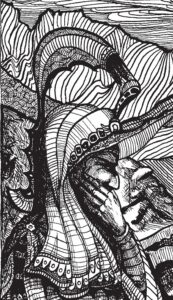
It is worth keeping in mind that Empire of the Petal Throne (EPT) was one of the first roleplaying games published after Original D&D. The fact that it is well-written and laid-out in a clean and attractive fashion for the time can mask this fact. But that also means that there are things not necessarily present in EPT that we might otherwise expect to be there — or not as well explained as you might like — and it can be a little jarring to stumble across that when you want to set up your game. What are some of those elements found initially in the game which need more attention?
- The combat sequence is not fully explained. Instead, you have to interpolate Sec. 720-23 and Sec. 1123 in order to figure out how combat is supposed to work. There is still some vagueness around some issues, such as when missile fire takes place, as well. How do you deal with that? The following is a very brief summary of how combat is supposed to happen. In EPT, combat operates on side initiative in the following order: movement-magic-missiles-melee. (I’ll come back to this in another blog post.)
- Underworlds are deadly places — more deadly than in Original D&D. Quite probably, this makes the death rate amongst beginning characters higher than in OD&D. Given that character creation in EPT is a fair bit more complicated than in OD&D, and this can get frustrating. I need to analyze this more closely, but low-level monsters are lacking in EPT, and that can be a problem.
- Hirilákte Arena fighting is not well-modeled using the EPT combat system. EPT’s combat system is taken largely from OD&D, that’s true. But arena combat, with opponents paired off one-on-one, is not really modeled well in that system. Determine initiative, roll to see who hits, take damage, lather-rinse-repeat — this is dull, unless you add in something more. EPT recognizes this by suggesting two different rules sets if greater complexity is desired: “Rules for Wargames: Gladiatorial Combat” (now apparently out-of-print) and “War of Wizards” (forthcoming from The Tékumel Foundation). This needs more consideration.
- Possible missions are in tension with character freedom. In Sec. 900 you discover that player-characters can travel freely in the Empire only after reaching 3rd level of experience, but many missions require being able to travel (at least four out of the eleven possible in Sec. 1110). This seeming conflict is deliberate, since beginning player-characters are supposed to have patrons who will hire them. But this requires prior work on the part of the referee to construct suitable adventures — again, not unsolvable, but involves definitely more planning and thinking about the scale of the campaign.
- The important roles of temples and clans are implied, but not really explained. Temples are the source for learning new magical spells, and clans are the social cornerstone of Tsolyáni society — but neither fact is really fully explained in the rules. Some of this is due to an initial desire for abstraction, but given how playing Tékumel is so much a matter of acculturation, this feels like something oddly missed. Both of these things could use more attention.
Overall, there is a fairly complex system of player choices presented in EPT, and it can be easy to lose track of all of the interlocking elements. But once you really look at what is going on, you can discover how to present the world of Tékumel in an exciting way for your players. There are more issues worth looking at, e.g. experience points, Underworlds, Nexus points, Ancient technology, Imperial politics, legion warfare, (just to name a few) but I want to start with the issues noted above as a way to help referees new to Tékumel.

(1) I’ve always preferred bows, swords, then spells myself. casting time considerations.
(2) I think this is intentional. Monsters are only things you find deeper in the underworlds. The upper levels are generally still in use by humans, but their motives are a lot more clandestine than :on the street. And likely more hostile. Especially since there is unlikely to be any other witnesses to what happens.
(3) I always like a psychological phase before a duel, where the loser generally attacks first, but at a disadvantage because they “broke” first.
(5) This is very akin to early RQ where guilds and cults seemed to be quite sperate things from society in general, but later became much more integrated into the fabric of daily society and character. In other words the old requirements for initiation became something for someone outside the culture. Which is the case for the EPT Barbarian start.
Thank you for posting your comment here! Some thoughts:
One of the things I recall from the game I watched Barker run was that the players had slave torch bearers that were dispensible.
I routinely use “young” versions of monsters with fewer Hits. You could also suggest that players role up two characters, which is how I ended up running three characters in Dad’s D&D game.
These are all excellent suggestions (although I have to admit that later, Prof. Barker made slaves more valuable and perhaps less likely to be “cannon fodder”). Rolling up two characters also provides a chance to think about who would be more interesting to play. Thanks, Chris!